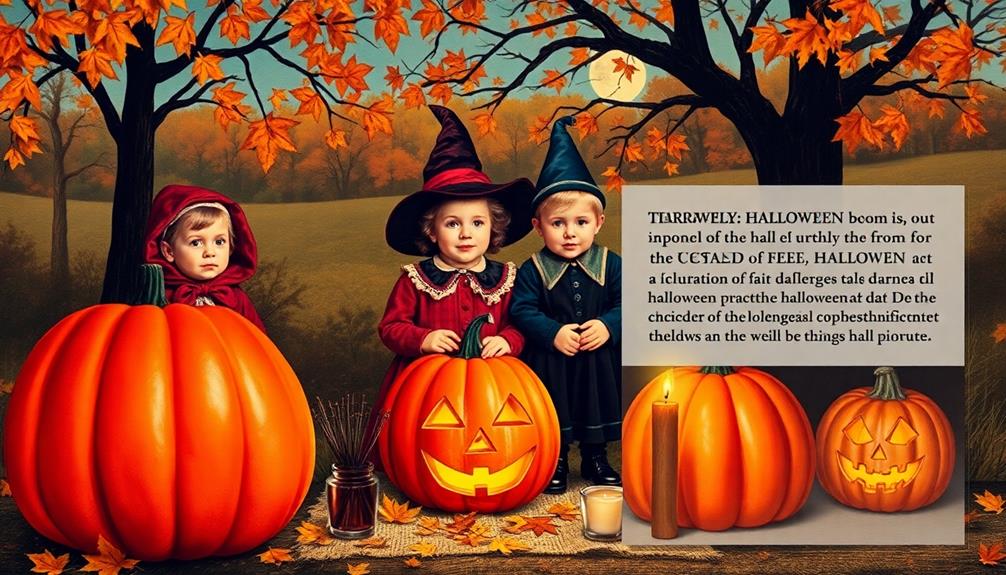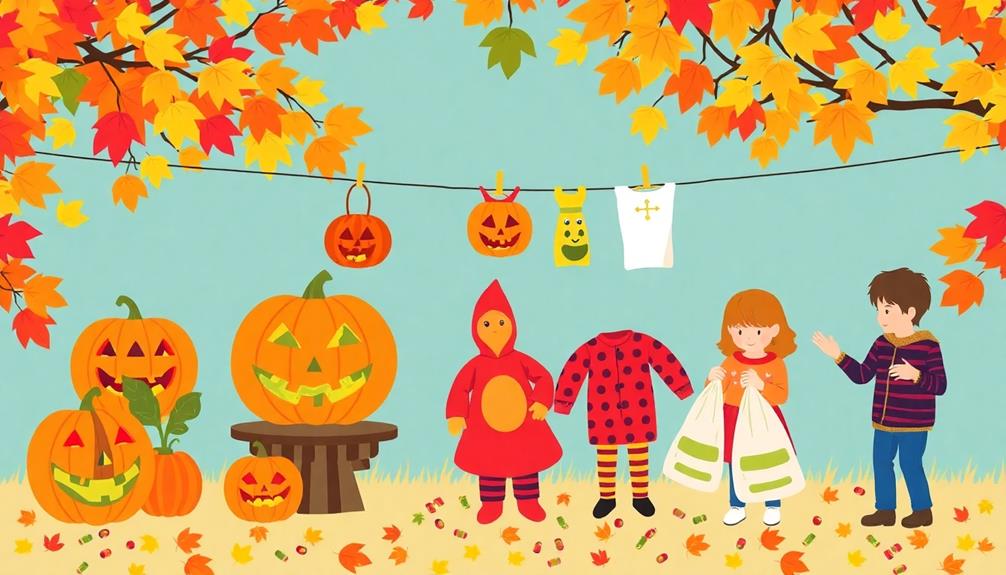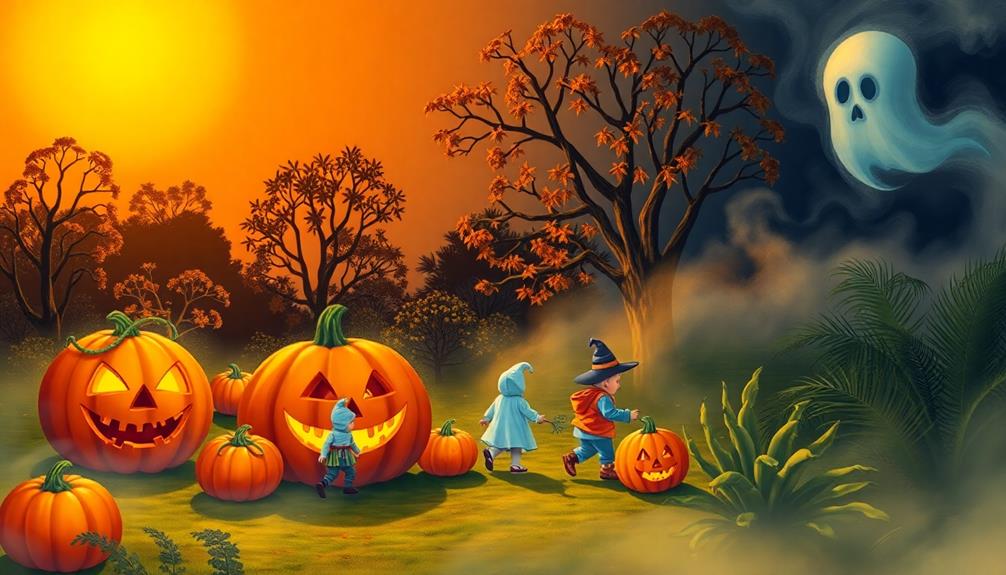Climate change's impact on Halloween traditions is significant. Rising temperatures and extreme weather events threaten pumpkin and apple harvests, causing over a billion pounds of pumpkin waste each year. This affects everything from decorations to Halloween treats. As crops dwindle, you'll notice prices rising and quality declining, altering your celebration experience. Additionally, the waste generated from costumes and candy packaging adds to the environmental burden. Awareness is growing, and many are turning to sustainable practices to keep tradition alive. There's much more to explore regarding how people adapt to these changes and preserve the essence of Halloween.
Key Takeaways
- Rising temperatures and extreme weather events threaten traditional harvests like pumpkins and apples, impacting Halloween celebrations globally.
- Increased crop vulnerability due to climate change leads to significant waste, with over 1 billion pounds of pumpkins discarded annually.
- The environmental consequences of Halloween-related waste, including costumes and candy packaging, contribute to global plastic pollution issues.
- Communities are increasingly adopting sustainable practices, such as composting pumpkins and creating DIY costumes, to mitigate Halloween's environmental impact.
- Climate change awareness is fostering community engagement initiatives focused on sustainability, addressing food waste, and promoting eco-friendly traditions.
Historical Context of Halloween

Halloween, celebrated on October 31st, has deep roots in the ancient Celtic festival of Samhain, where people believed the line between the living and the dead blurred, allowing spirits to roam freely.
This cultural celebration marked the end of the harvest season and the beginning of winter, a time when the ancient Celts honored their ancestors and sought to ward off evil spirits.
In America, early settlers largely ignored Halloween, influenced by their Protestant beliefs. However, the traditions revived in the 19th century, largely thanks to Irish immigrants who brought their customs with them.
Modern Halloween costumes evolved from ancient practices, where dressing up was intended to protect against malevolent spirits.
Today, Halloween is a rich tapestry of cultural influences, blending European and Native American traditions. You can see this in the widespread practice of trick-or-treating and the elaborate costumes people wear.
It's fascinating how these ancient customs have transformed into a widely celebrated secular holiday, with Americans spending over $10 billion annually on decorations, costumes, and candy.
Halloween's historical context highlights its journey from a spiritual observance to a festive celebration enjoyed by millions.
Climate Change's Impact on Harvests

As autumn approaches, the impact of climate change on harvests becomes increasingly evident, particularly for seasonal staples like pumpkins and apples. Over the past few decades, global warming has caused significant increases in October minimum temperatures across 88% of U.S. cities, disrupting traditional harvest timings. This shift in climate not only affects crop yields but also increases the urgency for farmers to adopt sustainable practices, such as utilizing renewable energy sources to power their operations.
Local farmers face mounting challenges, as extreme weather events like droughts and floods jeopardize their crops. This unpredictability has led to a staggering annual waste of over 1 billion pounds of pumpkins, which not only affects supply but also contributes to greenhouse gas emissions when they end up in landfills.
The sensitivity of crops like pumpkins to climate variations means farmers must adapt quickly. They're starting to implement new agricultural practices to cope with shifting weather patterns, but the future remains uncertain. With 12 key crops, including pumpkins, increasingly vulnerable, the quality and availability of traditional Halloween produce are at risk.
As you plan your fall festivities, it's vital to recognize how these environmental changes are shaping the harvests that make your celebrations possible. Understanding the connections between climate change and agricultural sustainability is essential for preserving our seasonal traditions.
Environmental Consequences of Celebrations

Celebrations often come with a hidden cost to the environment, and Halloween is no exception. Each year, nearly 12 million pounds of textile waste from discarded costumes end up in U.S. landfills, with most costumes made from non-biodegradable plastics. This excessive plastic consumption contributes considerably to climate change, as it's derived from oil, pushing global temperatures higher.
Moreover, around 900,000 tons of pumpkins produced annually in the U.S. become pumpkin waste, with rotting pumpkins releasing methane, a potent greenhouse gas that exacerbates climate change.
The candy you enjoy also has its environmental footprint; much of it's wrapped in non-recyclable plastic, adding to the 500,000 tons of plastic fibers entering our oceans every year.
These practices don't just generate waste—they also disrupt local ecosystems and contribute to the broader plastic pollution crisis.
As you celebrate Halloween, it's essential to recognize these environmental consequences and consider how your choices impact our planet. By being mindful of what you buy and how you dispose of it, you can help mitigate these harmful effects and celebrate with less environmental harm.
Sustainable Practices for Halloween

There are plenty of ways to make your Halloween more sustainable while still having fun. Start by using real pumpkins for cooking and composting instead of tossing them in the trash. This simple switch can help reduce the estimated 900,000 tons of pumpkin waste generated in the U.S. each year, contributing to reducing greenhouse gases.
Additionally, consider using natural elements for your decorations, which can enhance the ambiance while being eco-friendly.
Consider creating DIY costumes and decorations. By avoiding oil-based plastics, which make up 83% of costume materials, you can markedly lessen the 2,000 tons of plastic waste generated during Halloween.
Buying candy in bulk with minimal packaging is another effective way to decrease plastic waste. Remember, nearly a quarter of annual candy sales peak during this holiday.
Participate in community events focused on sustainability, like pumpkin recycling initiatives and eco-friendly costume swaps. These gatherings not only foster collective responsibility but also help reduce individual waste during your Halloween celebrations.
Finally, get creative by using natural materials like leaves and newspapers for decorations. This practice promotes sustainability while minimizing the environmental impact of non-biodegradable decorations often used during this festive season.
Embracing these sustainable practices can make your Halloween enjoyable and eco-friendly!
Community Engagement and Awareness

While many people enjoy Halloween traditions, the growing awareness of their environmental impact has sparked a push for community engagement. You mightn't realize that about 900,000 tons of pumpkins produced in the U.S. each year end up in landfills, contributing to methane emissions. This waste not only intensifies climate change but also highlights the need for sustainable practices, as seen in the impacts of wood-burning on environmental health.
Local initiatives are tackling this issue by promoting sustainable Halloween practices, such as DIY costumes and decorations. By getting creative, families reduce their reliance on plastic-based products that generate significant waste.
Educational programs, supported by organizations like Greenly, provide valuable resources for communities to assess their carbon footprints and adopt strategies to lower their environmental impacts during Halloween celebrations. Community events like pumpkin composting drives foster collaboration and raise awareness about food waste and its effects on climate change.
Additionally, local farmers and agricultural organizations are stepping up, discussing the impacts of climate change on crop production, and emphasizing the importance of sustainable practices.
Frequently Asked Questions
What Are the Environmental Issues With Halloween?
You might not realize Halloween's environmental issues. From pumpkins wasting away in landfills to costume plastics polluting oceans, excessive waste and non-biodegradable materials create significant pollution problems that you can help combat with sustainable choices.
How Is Climate Change Affecting Pumpkins?
You might not realize it, but climate change's rising temperatures and extreme weather are shrinking pumpkin yields. These challenges threaten your favorite fall decorations and treats, making it harder to find that perfect Halloween pumpkin.
What Are the Scary Statistics on Climate Change?
You might find it scary that global temperatures could rise by 1.5°C in two decades, with over 900,000 tons of pumpkins wasted each Halloween, contributing to significant methane emissions and worsening climate change.
How Did Halloween Traditions Change Over Time?
Halloween traditions evolved from ancient rituals to modern festivities, shifting focus from scaring spirits to social gatherings. You'll notice how customs like trick-or-treating and costume-wearing reflect these changes throughout history, adapting to cultural influences.
Conclusion
As Halloween approaches, think of it as a mirror reflecting our changing climate. The traditions we cherish are being reshaped by shifting weather patterns and environmental challenges. By embracing sustainable practices and engaging with our communities, you can help guarantee that Halloween remains a vibrant celebration for generations to come. Let's not let our beloved customs fade like autumn leaves; instead, let's nurture them, ensuring they thrive amidst the changes around us.










